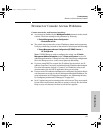
8-9
Troubleshooting
Unusual Network Activity
Troubleshooting
STP-Related Problems
Caution If you enable STP, it is recommended that you leave the remainder of the STP
parameter settings at their default values until you have had an opportunity
to evaluate STP performance in your network. Because incorrect STP settings
can adversely affect network performance, you should avoid making changes
without having a strong understanding of how STP operates. To learn the
details of STP operation, refer to the IEEE 802.1d standard.
Broadcast Storms and/or Duplicate MAC Addresses Appearing in the
Network. This can occur where STP is not detecting physical loops (redun-
dant links).Where this exists, you should enable STP on all bridging devices
in the loop in order for the loop to be detected.
The Spanning Tree Cost Configured on a Non-Meshed Port Will Not
Stay at the Configured Value. A redundant link situation exists between a
non-meshed port and a port in the switch mesh.
Figure 8-3. Example of Meshed and Nonmeshed Links Forming a Redundant Pair
Spanning Tree attempted to block the meshed port. In this situation, the
meshed switch automatically increases the STP cost on the non-meshed
redundant link so that STP will block the nonmeshed port and open the
meshed port. Refer to “STP Operation with Switch Meshing” on page 6-45.
If you are experienced with STP, then it is recommended that you set up your
topology and STP configuration so that one of the meshed switches is the root
switch.
Mesh
Switch
“A”
Mesh
Switch
“C”
Mesh
Switch
“B”
Switch Mesh Domain
Nonmesh
Switch “X”
The mesh path and the
nonmesh path form
redundant links. STP
will eventually block
the nonmesh link
because the cost for
the nonmeshed path
will be automatically
increased above that
for the meshed path.
(Switches “A” and “C”
are “edge switches”—
refer to page 6-82.)
Nonmeshed Links
Meshed Links


















